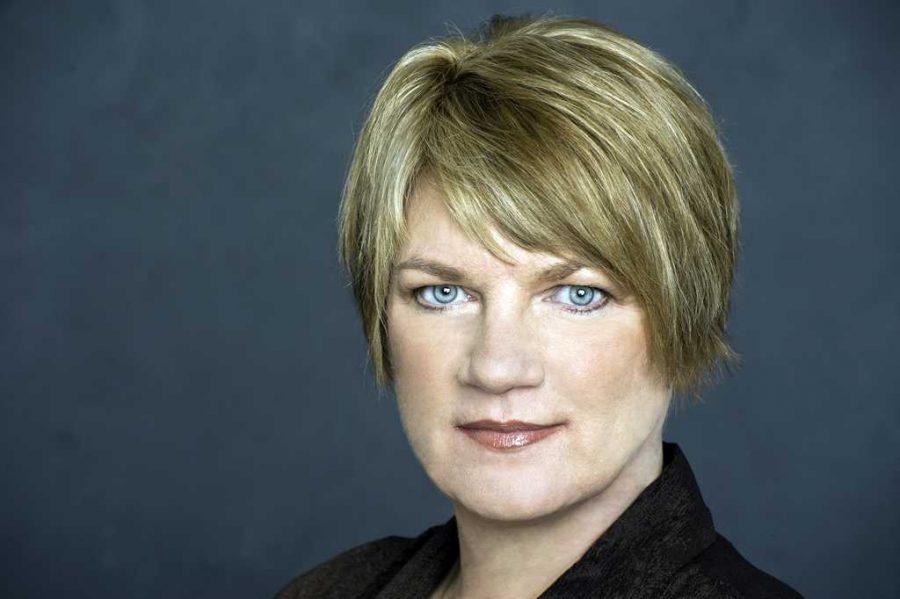Before a slew of NFL allegations, outcry over football and a blockbuster film, a journalist was chasing her curiosity to concussion research.
Jeanne Marie Laskas’ GQ article-turned-book and now film adaptation “Concussion,” didn’t start as the controversial lightning rod it is today. The story, about forensic pathologist Bennet Omalu’s discovery of chronic traumatic encephalopathy, or CTE, began as an inquiry into the science behind concussions and ended up changing how America thinks about one of its biggest institutions.
The author, who is also Pitt’s Writing Department director, transformed Omalu’s research into an article for GQ Magazine in 2009. In 2015, the story developed into the full-length book and film adaptation, which was shot in the Steel City and starred Will Smith.
Laskas spoke with The Pitt News about her story, her role in the film adaptation and how her relationship with football has changed.
The Pitt News: Your story started out as an article and then turned into a book and now it’s a movie. What inspired you to initially take on this topic?
Jeanne Marie Laskas: When I first wrote the story, the work for that was under the rubric of the stories that I do for GQ Magazine. The idea was really just a conversation with my editor about a subject that was really in the news a lot in 2009 — about concussions. So there was a lot of conversation, and the question was, do we have anything to add to the conversation?
My original reaction was probably not, because it seemed to me that it had been so well covered. But I started digging a little bit, mostly because I didn’t understand well enough [about] the science and what really we were talking about that was going on in the brains of traumatic brain injury patients — in this case, football players. So as I dug into the science and sort of started from the beginning, I found this article by this guy Bennet Omalu [about] finding CTE in a football player. His name had fallen off the map, and I wondered who he was, how he figured this out and what happened to him. That was my interest really, was in finding the scientist that started the whole thing.
TPN: What were you hoping people would get out of reading this story?
JML: I think initially, just awareness because, as I said, it had been in the headlines. But what’s really going on here? And once I learned what was really going on and how this scientist had been silenced, I was like well, people need to know that. There’s kind of a concerted effort to blur and to make sure people don’t understand what’s going on. And then I was like, well, people need to understand.
TPN: So you just set out to write this profile, you weren’t trying to address the NFL or take on this big topic. You just wanted to tell this person’s story, right?
JML: Yeah, because his story was so interesting and had never been told. And he had been kind of ousted—well, he had been ousted from all sides. And how he figured it out was so fascinating, you know, like taking this brain on and all this independent researching funded by no government, no university, nothing — just his own pure, scientific quest. And that’s just an interesting story. So that’s it. I was, like, interested in the guy, not trying to change society. That’s just not my approach to stories. I’m more, what is the dramatic narrative that can carry a larger message to a readership? What’s the dramatic story? As a storyteller, that’s what you do.
And honestly, there’s a parallel because I didn’t know that much about football either. The way that Bennet had no agenda going into this as a scientist, I sort of was the same way. I really had no agenda going into it as a journalist. It wasn’t like I’m setting out to right a wrong or any of that stuff. In that sense, my perspective was different from, say, a sports writer’s perspective, who comes in understanding the NFL and the League and the implications and knows the team and the coaches and the politics behind it all. So I kind of came into it in a naive way, as did Bennet.
TPN: Even though you’re not a sports writer, were you still a football fan before taking on this story?
JML: Yeah, like a regular Pittsburgher.
TPN: Did you look at the NFL and football in general the same way after researching and writing this book?
JML: It became so complicated and — no. I can’t watch it the same way, it’s distraught for me.
It’s like once you really understand, you as a fan are complicit in the problem because you’re not doing — you’re participating. You’re sitting there eating your chicken wings, knowing what is probably happening and that maybe there’s nobody doing anything about it. It becomes a real ethical question, and one of the things that happens in the book, certainly, and in the movie, is starting that conversation. Like, what do we do, you know? Do we keep ignoring this problem or are we all going to do something about it?
TPN: What kind of people did you talk to and what kind of questions did you ask them when researching the story?
JML: My initial kind of burst of research was obviously, just all the reading … all that I could to understand the history of this thing. And then I spent a lot of time with Bennet and Julian Bailes, who was at West Virginia University, who’s the Alec Baldwin character now in the movie. Bob Fitzsimmons, the attorney — they were sort of a trio involved in the early days with Mike Webster. So a lot of that early stuff I put together by just tons and tons of research with them, but then you expand out to other scientists who are doing other kinds of areas of research. And then, of course, NFL players and NFL player families who’ve sort of lived this. So those are the areas I was focusing my research.
TPN: How involved were you with the film adaptation?
JML: Well, let’s see. I was a consultant on the film, which could mean anything with the filmmakers on what they want to do. So, make myself available for consultations, to share research, to read scripts as was helpful in any way. And then I spent quite a bit of time on the set because they were filming it here in Pittsburgh, so that was more for me, because it was fun. How a consultant works on a film is really however you’re helpful.
TPN: What was your favorite part about being on set during that time?
JML: What I loved the most was, especially because that time I was pretty well deep into the book, what I loved was that all the people I was writing about or had written about kept coming by to watch them be portrayed. So Bailes was there, and Father Carmen — the real Father Carmen, who plays a role in the book but in the movie he’s just a blip. So all those people, Ron Hamilton. That’s it — just that was a unique experience. You had the actual characters, then the movie actors portraying them and all of us kind of in one room, making this happen. It was really a once-in-a-lifetime kind of experience for a writer. You spend so much time with your characters on the page. That was really unique and fun.
Something about Will Smith — who was amazing — there portraying Bennet, who had been so much fun with. And he was so inhabiting Bennet, that was fascinating. And to see him be able to switch it on and off. Oh my God, it’s almost like creepy, it was so cool.
TPN: So, in truth, how accurate was the movie to the book, or to the actual story?
JML: The movie really follows the beat that the original GQ story [follows]. It stays true to sort of the way that it all happened. Now, mind you, it’s not a documentary, it’s an adaption. So there are parts that are moved around or mushed together in order to sort of dramatize the true story. But it’s a true story in that yes, Bennet walked that path and yes, he found this disease in this guy and then he did this with it and the NFL came after him this way. So, I would say it stays true to the narrative, with embellishment for a moviegoing audience. It’s a movie.
TPN: Overall, are you satisfied with this adaptation?
JML: Oh, absolutely. I really am, and I’m really glad they took it on and took it on so seriously, and didn’t compromise.
It’s quite a feat, really. Again, it’s not a documentary. It’s like, OK, let’s make this into a story that will work on film. So that’s gratifying.



